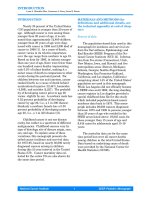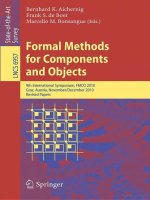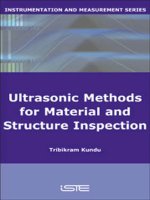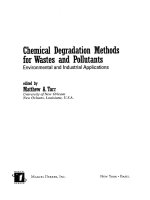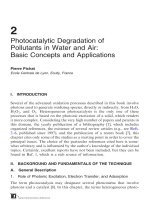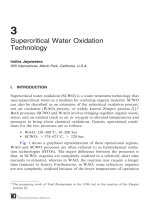Ultrasonic Methods for Material and Structure Inspection pdf
Bạn đang xem bản rút gọn của tài liệu. Xem và tải ngay bản đầy đủ của tài liệu tại đây (6.6 MB, 408 trang )
Advanced Ultrasonic Methods for Material and Structure Inspection
This page intentionally left blank
Advanced Ultrasonic
Methods for Material and
Structure Inspection
Edited by
Tribikram Kundu
Series Editor
Dominique Placko
First published in Great Britain and the United States in 2007 by ISTE Ltd
Apart from any fair dealing for the purposes of research or private study, or criticism or
review, as permitted under the Copyright, Designs and Patents Act 1988, this publication may
only be reproduced, stored or transmitted, in any form or by any means, with the prior
permission in writing of the publishers, or in the case of reprographic reproduction in
accordance with the terms and licenses issued by the CLA. Enquiries concerning reproduction
outside these terms should be sent to the publishers at the undermentioned address:
ISTE Ltd ISTE USA
6 Fitzroy Square
4308 Patrice Road
London W1T 5DX
Newport Beach, CA 92663
UK USA
www.iste.co.uk
© ISTE Ltd, 2007
The rights of Tribikram Kundu to be identified as the author of this work have been asserted
by him in accordance with the Copyright, Designs and Patents Act 1988.
Library of Congress Cataloging-in-Publication Data
Advanced ultrasonic methods for material and structure inspection/edited by Tribikram
Kundu.
p. cm.
Includes bibliographical references and index.
ISBN-13: 978-1-905209-69-9
ISBN-10: 1-905209-69-X
1. Ultrasonic testing. I. Kundu, T. (Tribikram)
TA417.4.A38 2006
620.1'1274 dc22
2006032329
British Library Cataloguing-in-Publication Data
A CIP record for this book is available from the British Library
ISBN 10: 1-905209-69-X
ISBN 13: 978-1-905209-69-9
Printed and bound in Great Britain by Antony Rowe Ltd, Chippenham, Wiltshire.
To my wife, Nupur, our daughters, Ina and Auni and our parents,
Makhan Lal Kundu, Sandhya Rani Kundu, Jyotirmoy Naha and Rubi Naha
This page intentionally left blank
Table of Contents
Preface xiii
Chapter 1. An Introduction to Failure Mechanisms and Ultrasonic
Inspection 1
Kumar V. JATA, Tribikram KUNDU and Triplicane A. PARTHASARATHY
1.1. Introduction 1
1.2. Issues in connecting failure mechanism, NDE and SHM 2
1.3. Physics of failure of metals 4
1.3.1. High level classification 4
1.3.1.1. Deformation 5
1.3.1.2. Fracture 5
1.3.1.3. Dynamic fatigue 6
1.3.1.4. Material loss 7
1.3.2. Second level classification 7
1.3.2.1. Deformation due to yield 7
1.3.2.2. Creep deformation and rupture 9
1.3.2.3. Static fracture 12
1.3.2.4. Fatigue 13
1.3.2.5. Corrosion 18
1.3.2.6. Oxidation 20
1.4. Physics of failure of ceramic matrix composites 21
1.4.1. Fracture 23
1.4.1.1. Mechanical loads and fatigue 23
1.4.1.2. Thermal gradients 24
1.4.1.3. Microstructural degradation 25
1.4.2. Material loss 25
1.5. Physics of failure and NDE 26
viii Advanced Ultrasonic Methods for Material and Structure Inspection
1.6. Elastic waves for NDE and SHM 26
1.6.1. Ultrasonic waves used for SHM 26
1.6.1.1. Bulk waves: longitudinal and shear waves 27
1.6.1.2. Guided waves: Rayleigh and Lamb waves, bar, plate and
cylindrical guided waves 28
1.6.2. Active and passive ultrasonic inspection techniques 30
1.6.3. Transmitter-receiver arrangements for ultrasonic inspection 30
1.6.4. Different types of ultrasonic scanning 31
1.6.5. Guided wave inspection technique 32
1.6.5.1. One transmitter and one receiver arrangement 32
1.6.5.2. One transmitter and multiple receivers arrangement 35
1.6.5.3. Multiple transmitters and multiple receivers arrangement 36
1.6.6. Advanced techniques in ultrasonic NDE/SHM 36
1.6.6.1. Lazer ultrasonics 36
1.6.6.2. Measuring material non-linearity 37
1.7. Conclusion 38
1.8. Bibliography 38
Chapter 2. Health Monitoring of Composite Structures Using Ultrasonic
Guided Waves 43
Sauvik BANERJEE, Fabrizio RICCI, Frank SHIH and Ajit MAL
2.1. Introduction 43
2.2. Guided (Lamb) wave propagation in plates 46
2.2.1. Lamb waves in thin plates 51
2.2.2. Lamb waves in thick plates 55
2.3. Passive ultrasonic monitoring and characterization of low velocity
impact damage in composite plates 60
2.3.1. Experimental set-up 60
2.3.2. Impact-acoustic emission test on a cross-ply composite plate 64
2.3.3. Impact test on a stringer stiffened composite panel 71
2.4. Autonomous active damage monitoring in composite plates 75
2.4.1. The damage index 76
2.4.2. Applications of the damage index approach 77
2.5. Conclusion 85
2.6. Bibliography 86
Chapter 3. Ultrasonic Measurement of Micro-acoustic Properties of
the Biological Soft Materials 89
Yoshifumi SAIJO
3.1. Introduction 89
3.2. Materials and methods 91
Table of Contents ix
3.2.1. Acoustic microscopy between 100 and 200 MHz 91
3.2.2. Sound speed acoustic microscopy 95
3.2.3. Acoustic microscopy at 1.1 GHz 98
3.3. Results 99
3.3.1. Gastric cancer 99
3.3.2. Renal cell carcinoma 103
3.3.3. Myocardial infarction 104
3.3.4. Heart transplantation 106
3.3.5. Atherosclerosis 107
3.4. Conclusion 112
3.5. Bibliography 112
Chapter 4. Corrosion and Erosion Monitoring of Pipes by an Ultrasonic
Guided Wave Method 115
Geir INSTANES, Mads TOPPE, Balachander LAKSHMINARAYAN, and
Peter B. NAGY
4.1. Introduction 115
4.2. Ultrasonic guided wave monitoring of average wall thickness
in pipes 118
4.2.1. Guided wave inspection with dispersive Lamb-type
guided modes 119
4.2.2. Averaging in CGV inspection 123
4.2.3. The influence of gating, true phase angle 129
4.2.4. Temperature influence on CGV guided wave inspection 132
4.2.5. Inversion of the average wall thickness in CGV guided
wave inspection 134
4.2.6. Additional miscellaneous effects in CGV guided
wave inspection 136
4.2.6.1. Fluid loading effects on CGV inspection 136
4.2.6.2. Surface roughness effects on CGV inspection 139
4.2.6.3. Pipe curvature effects on CGV inspection 141
4.3. Experimental validation 145
4.3.1. Laboratory tests 145
4.3.2. Field tests 151
4.4. Conclusion 153
4.5. Bibliography 155
Chapter 5. Modeling of the Ultrasonic Field of Two Transducers Immersed
in a Homogenous Fluid Using the Distributed Point Source Method 159
Rais AHMAD, Tribikram KUNDU and Dominique PLACKO
5.1. Introduction 159
5.2. Theory 160
x Advanced Ultrasonic Methods for Material and Structure Inspection
5.2.1. Planar transducer modeling by the distribution of point source
method 160
5.2.2. Computation of ultrasonic field in a homogenous fluid
using DPSM 161
5.2.3. Matrix formulation 163
5.2.4. Modeling of ultrasonic field in a homogenous fluid in the presence
of a solid scatterer 165
5.2.5. Interaction between two transducers in a homogenous fluid 169
5.3. Numerical results and discussion 171
5.3.1. Interaction between two parallel transducers 172
5.3.2. Interaction between an inclined and a flat transducer 184
5.3.3. Interaction between two inclined transducers 185
5.4. Conclusion 186
5.5. Acknowledgments 186
5.6. Bibliography 187
Chapter 6. Ultrasonic Scattering in Textured Polycrystalline Materials 189
Liyong YANG, Goutam GHOSHAL and Joseph A. TURNER
6.1. Introduction 189
6.2. Preliminary elastodynamics 191
6.2.1. Ensemble average response 191
6.2.2. Spatial correlation function 195
6.3. Cubic crystallites with orthorhombic texture 197
6.3.1. Orientation distribution function 197
6.3.2. Effective elastic stiffness for rolling texture 199
6.3.3. Christoffel equation 201
6.3.4. Wave velocity and polarization 202
6.3.5. Phase velocity during annealing 207
6.3.6. Attenuation 210
6.4. Attenuation in hexagonal polycrystals with texture 215
6.4.1. Effective elastic stiffness for fiber texture 216
6.4.2. Attenuation 220
6.4.3. Numerical simulation 223
6.5. Diffuse backscatter in hexagonal polycrystals 229
6.6. Conclusion 232
6.7. Acknowledgments 233
6.8. Bibliography 233
Table of Contents xi
Chapter 7. Embedded Ultrasonic NDE with Piezoelectric Wafer Active
Sensors 237
Victor GIURGIUTIU
7.1. Introduction to piezoelectric wafer active sensors 237
7.2. Guided-wave ultrasonic NDE and damage identification 240
7.3. PWAS ultrasonic transducers 242
7.4. Shear layer interaction between PWAS and structure 244
7.5. Tuned excitation of Lamb modes with PWAS transducers 246
7.6. PWAS phased arrays 249
7.7. Electromechanical impedance method for damage identification 255
7.8. Damage identification in aging aircraft panels 258
7.8.1. Classification of crack damage in the PWAS near-field 259
7.8.2. Classification of crack damage in the PWAS medium-field 260
7.8.2.1. Impact detection with piezoelectric wafer active sensors 263
7.8.2.2. Acoustic emission detection with piezoelectric wafer
active sensors 266
7.9. PWAS Rayleigh waves NDE in rail tracks 268
7.10. Conclusion 268
7.11. Acknowledgments 269
7.12. Bibliography 269
Chapter 8. Mechanics Aspects of Non-linear Acoustic Signal Modulation
due to Crack Damage 273
Hwai-Chung WU and Kraig WARNEMUENDE
8.1. Introduction 273
8.1.1. Passive modulation spectrum 274
8.1.2. Active wave modulation 275
8.2. Damage in concrete 275
8.3. Stress wave modulation 280
8.3.1. Material non-linearity in concrete 281
8.3.2. Generation of non-linearity at crack interfaces 282
8.3.3. Unbonded planar crack interface in semi-infinite elastic media. . . 289
8.3.4. Unbonded planar crack interface with multiple wave interaction. . 295
8.3.5. Plane crack with traction 301
8.3.6. Rough crack interface 307
8.4. Summary and conclusion 314
8.5. Bibliography 315
xii Advanced Ultrasonic Methods for Material and Structure Inspection
Chapter 9. Non-contact Mechanical Characterization and Testing of
Drug Tablets 319
Cetin CETINKAYA, Ilgaz AKSELI, Girindra N. MANI,
Christopher F. LIBORDI and Ivin VARGHESE
9.1. Introduction 319
9.2. Drug tablet testing for mechanical properties and defects 321
9.2.1. Drug tablet as a composite structure: structure of a typical
drug tablet 321
9.2.2. Basic manufacturing techniques: cores and coating layers 322
9.2.3. Tablet coating 323
9.2.4. Types and classifications of defects in tablets 325
9.2.5. Standard tablet testing methods 327
9.2.6. Review of other works 330
9.3. Non-contact excitation and detection of vibrational modes of
drug tablets 332
9.3.1. Air-coupled excitation via transducers 334
9.3.2. LIP excitation via a pulsed lazer 336
9.3.3. Vibration plate excitation using direct pulsed lazer irradiation . . . 338
9.3.4. Contact ultrasonic measurements 340
9.4. Mechanical quality monitoring and characterization 341
9.4.1. Basics of tablet integrity monitoring 341
9.4.2. Mechanical characterization of drug tablet materials 356
9.4.3. Numerical schemes for mechanical property determination 361
9.5. Conclusions, comments and discussions 365
9.6. Acknowledgments 367
9.7. Bibliography 367
Chapter 10. Split Hopkinson Bars for Dynamic Structural Testing 371
Chul Jin SYN and Weinong W. CHEN
10.1. Introduction 371
10.2. Split Hopkinson bars 372
10.3. Using bar waves to determine fracture toughness 374
10.4. Determination of dynamic biaxial flexural strength 380
10.5. Dynamic response of micromachined structures 381
10.6. Conclusion 383
10.7. Bibliography 384
List of Authors 387
Index 391
Preface
Today, the ultrasonic signal is being used for predicting material behavior,
characterizing (detecting internal anomalies in) a variety of engineering structures,
as well as for inspecting human body parts like tumors, bones, and unborn fetuses.
Because of the ever-increasing popularity of the ultrasonic techniques in a wide
range of applications, this technology has received a lot of attention from the
research community. This book presents some new developments in ultrasonic
research for material and structure inspection. Application areas cover both
engineering and biological materials.
Some of the recent advances in the science and technology of ultrasonic NDE
and other areas of research on ultrasonic technology that go beyond the traditional
imaging techniques of internal defects are covered in this book. New inspection and
material characterization techniques applied to engineering structures, as well as
biological materials, are presented here. Ten chapters cover a wide range of
application areas of the ultrasonic technology. From the first chapter the reader will
learn various failure mechanisms associated with different types of engineering
materials and will get an overview of the current ultrasonic NDE/SHM techniques.
This chapter will help to bridge the gap between the materials scientists and the
mechanics community in their understanding and approach to the nondestructive
evaluation and health monitoring of engineering materials and structures. From the
subsequent chapters the reader will learn:
– how to measure and predict the impact damage in composite panels by
analyzing the impact damage generated ultrasonic signals: a combined experimental
and theoretical study of the Lamb wave propagation and generation by the low
velocity impact in composite panels is important for this purpose, and is presented
here in the hope that it will eventually develop an impact monitoring system in the
future;
– how to measure and interpret the ultrasonic properties of soft biological
tissues: scanning acoustic microscopes can measure attenuation and wave speed in
xiv Advanced Ultrasonic Methods for Material and Structure Inspection
soft tissues. From these properties the biomechanics of the tissues can be assessed
that might improve our understanding of diseases from a micro-mechanical point of
view;
– how to monitor corrosion and erosion damages in pipelines using cylindrical
guided waves, which guided wave mode is most efficient to detect the wall
thickness reduction over a long range and how to generate this mode in the pipe;
– how to accurately model the ultrasonic field generated by multiple transducers:
in defect detection and health monitoring applications when multiple sensors are
used, the accurate modeling of the ultrasonic pressure and velocity fields in the near
field region is important. The distributed point source method (DPSM) for modeling
the ultrasonic fields including the interaction effects is presented;
– how the ultrasonic wave propagation characteristics, often used for
microstructure inspection, are influenced by the texture. The propagation and
scattering of ultrasonic waves in textured polycrystals are discussed in Chapter 6.
This is important for material microstructure inspection by ultrasonic waves;
– how embedded piezoelectric ultrasonic sensors are used for health monitoring
of large plate type structures. A rigorous study of the interaction between ultrasonic
Lamb waves and embedded piezoelectric wafer active sensors is necessary for this
purpose;
– what is the effect of cracks on the acoustic signal modulation. What material
properties, signal characteristics and crack dimensions affect this modulation. This
study is important for gaining knowledge about the material damage and geometric
non-linearity from the modulation of the signal propagated through the material;
– how to measure the dynamic response of materials using split Hopkinson bars
and what issues are important and how to design the experiments for accurately
measuring these dynamic properties.
It is my hope that both biological and physical science communities will gain
some new knowledge from this book that will stimulate new research resulting in
the development of more innovative ultrasonic technology applications.
I would like to thank the authors for timely submission of their chapters. My
special thanks go to Professor Dominique Placko for encouraging me to take this
project and to the publisher for giving me this opportunity.
Tribikram Kundu
University of Arizona, USA
Chapter 1
An Introduction to Failure Mechanisms
and Ultrasonic Inspection
1.1. Introduction
Future inspections of aerospace systems and other engineering structures are
expected to be based on a combination of non-destructive evaluation (NDE) and
structural health monitoring (SHM) technologies. Here SHM will be employed
online or in real-time to detect damage at a global level and then NDE will be used
to characterize the damage in terms of size and physics of the damage mode (or
failure mechanism). Proper implementation, correct interpretation of the results and
advancement of both these technologies for the analysis of engineering failures will
require a certain amount of understanding of material behavior and material damage
modes. This chapter is written with this in mind and the objective is to give the
reader an overview of various failure mechanisms that can occur in structural
metallic materials and ceramic matrix composites. This is then followed with a brief
discussion of damage detection techniques using ultrasonic waves in metals and
composites. Organic matrix composites have been intentionally omitted due to the
limited scope of the chapter.
Continuous, autonomous, real-time, in-service monitoring of the condition of a
structure with minimum manual intervention is known as structural health
monitoring or SHM. In recent years SHM has received much attention from
different disciplines of science and engineering including NDE. Real-time NDE-
based sensing methodologies for structural damage and material state are being
Chapter written by Kumar V. JATA, Tribikram KUNDU and Triplicane A. PARTHASARATHY.
2 Advanced Ultrasonic Methods for Material and Structure Inspection
developed and in order to monitor these states it is important to know what damage
and material states are being sensed and how the material state change may be
progressing. Without such knowledge the sensor output generated during flight or
during system operation may prove to be of little value.
The purpose of this chapter is not to review the SHM-related investigations that
have been carried out so far, but to bridge the gap between the mechanics and
materials community on SHM-related knowledge and understanding. The mechanics
community often fails to see the importance of the type of material used when
designing an SHM system for a specific structural component or material. As an
example, the analysis and design-based on Young’s modulus and Poisson’s ratio
does not necessarily produce two SHM systems for two different materials because
the failure mechanisms for the two materials can be completely different. A good
understanding of different failure mechanisms for various materials is needed for
designing efficient SHM systems for different structural components made of
various types of material. Similarly, it is also important for materials scientists to
understand the basic mechanics behind SHM systems for better communication and
collaboration with the mechanics community. This collaboration is important for
jointly developing appropriate SHM systems. This chapter has been written with this
goal in mind.
1.2. Issues in connecting failure mechanism, NDE and SHM
Microcrack nucleation, macrocrack formation and crack extension are well
understood in metals, ceramics, ceramic matrix composites (CMC), polymer matrix
composites and carbon-carbon (C-C) composites. Most of this understanding is
based on tests on laboratory samples in well controlled environments and many new
materials have been developed in recent years based on such understanding.
However, when alloys are scaled up from laboratory samples to large-scale product
forms or when the environment changes from that of a laboratory to that of a near-
operational environment, an undesired rate of failure progression may occur. The
contribution of materials to this undesired effect can be due to composition and
processing deviations. For example, chemical composition is not as easy to control
in large ingots (e.g. 10,000 lb) as in a small laboratory size ingot (e.g. 100 lb).
Similarly, larger variations in properties occur while processing large ingots during
component manufacturing (e.g. mid-thickness properties can vary substantially from
surface properties). Manufacturing processes can also introduce, for example, tensile
residual stresses or unintentional sharp radii which may curtail ductility or cause
faster crack propagation rates. Fracture modes can thus be different or accentuated
in components as compared to those in the laboratory samples. Life prediction
models also exist for many of the materials to predict their fatigue life in laboratory
setting and to some extent in operational/service environments. Here again, chemical
An Introduction to Failure Mechanisms and Ultrasonic Inspection 3
composition variations, impurity segregation, and manufacturing processes can
introduce large scatter and a reduction in mechanical properties compared to that in
the laboratory samples. This, combined with unanticipated changes or ill-defined
operational environments, can lead to inaccurate estimations of service life.
There is also a lack of connection between different levels of failures: from the
microstructure scale to the mesoscale to the macroscale level. A mathematical
framework and software algorithms are practically absent to connect these various
length scales, thus making it difficult to extrapolate the laboratory observed fracture
from an operating structure or system. So, most of the life prediction approaches are
overly conservative and structures that are employed have large safety margins
resulting in higher weight penalties than desired. In order to reduce the design
margin and to predict life more accurately, in recent years there has been an
increasing emphasis on prognosis of the remaining useful life of components on
physics-based damage models or models-based on microstructure and constitutive
properties. Such approaches are clearly needed to predict not only incipient damage
nucleation and propagation, but also how damage initiated in the first place. Cruse
(CRU1) pointed out that for a better prognosis of the mission capability of a system,
a new paradigm has to be adopted, i.e. characterize the material damage state
awareness rather than find a flaw with NDE. Understanding how the damage has
nucleated and how the damage will propagate under loads and service environment
requires some knowledge of materials behavior and the effect of microstructure
constituents on properties of interest. In the case of prognosis, efforts are underway
to develop life prediction models that incorporate microstructure, physics-based
damage models and crystal plasticity models. Needless to say, there are very few
sensors that can detect or track material state and damage state at a microstructural
level and research is being performed in this area.
Another point to note is that most of the current and proposed structures used for
harsh or extreme environments are quite complex in that not only are the materials
vastly different from each other, but also the assembling methods are uniquely
tailored to the specific operational environment. Many of these materials and
structures are subjected to severe thermal acoustic fatigue environments. The
complexity of materials and operational environment make ultrasonic-based SHM
very difficult, even if ultrasonic sensors that would survive these environments
existed. In the last two years the US Air Force Research Laboratory, Materials and
Manufacturing Directorate has begun to intensely investigate the areas of SHM for
aircrafts, gas turbine engines and space structures including cryotank and thermal
protection structures. Ultrasonic-based SHM research relating to these areas can be
found in the following references [CHA 05, KUN 06, SUN 04, SAT 06]. The reader
is urged to keep in mind that the ultrasonic methods that are used or developed for
NDE inspections, whether it is in a laboratory setting or in the field or depot, cannot
be directly translated into SHM. There are issues and challenges involved in
4 Advanced Ultrasonic Methods for Material and Structure Inspection
transitioning from NDE to real-time SHM. More information on this area is to be
found in [JAT 06].
While many material models have been developed over the past several decades,
without proper detection methods these models will remain underused by designers.
For example, the processing of materials has advanced to such a level, that the
detection of pre-existing flaws in these materials is a real challenge. However,
materials science has evolved over the years in order to be able to link
microstructural features to the initiation and growth of damage. Thus, the
measurement of microstructural features and any change that might occur during
service represent a significant opportunity for the next generation of NDE
techniques. We hope that the knowledge of the physics of failure in materials will
motivate NDE engineers to devise these next generation methodologies and
instrumentation. The first part of this chapter deals with the failure of materials at a
microstructure level that are very small scale events; however, over time these
microscale events ultimately hinder a component from performing its function
through failure. Knowledge of failure mechanisms has been successfully exploited
in developing new materials with improved properties by essentially eliminating or
modifying the microstructural constituents responsible for initiating failures in a
material. In order to assess damage, predict the remaining useful life of a component
and use the entire capability of a given material, it is critical to convey the physics of
failure of the material along with the material constitutive properties to the designers
involved in selecting materials and sizing components. Similarly, to build better
diagnostic systems capable of diagnosing damage at a microstructure level, the
physics of failure needs to be understood because damage nucleates at
microstructure inhomogenity. The smaller the scale of the inhomogenity, the smaller
the scale of the initial damage features. This chapter will attempt to summarize
failure modes in metals and ceramic matrix composites (CMCs) that can be used as
a first step in understanding failure modes and their connection to NDE, and also aid
in developing new sensors to detect damage and aid prognosis methods for life
prediction.
1.3. Physics of failure of metals
1.3.1. High level classification
At a high level, failure in metals or alloys can be broadly classified, as shown in
Table 1.1, under three categories: (I) deformation, (ii) fracture and (iii) material loss.
An Introduction to Failure Mechanisms and Ultrasonic Inspection 5
1.3.1.1. Deformation
A metallic alloy can fail to perform an assigned function due to excessive
deformation arising either from inferior yield strength at ambient temperatures or
through excessive creep at high temperatures. For instance, the improper selection of
material of higher operational temperatures, which exceed the capability of the
material strength, may lead to failure through deformation. As shown in Table 1.1,
deformation failures depend on either yield or creep phenomenon and are
fundamentally related to stress. Most of the plasticity associated with yield
phenomenon is athermal, whereas in the case of creep phenomenon thermal
plasticity plays a key role. Creep deformation resulting from the applied stress at
high temperatures is a function of time. Many of the components that undergo creep
deformation are therefore designed not to exceed a certain amount of deformation
under a given applied load and over a specified time interval.
1.3.1.2. Fracture
Fracture is a very broad term; however, at a high level it can be classified as
static, dynamic and creep rupture. Static fracture occurs in fracture mechanics
specimens or in uniaxially stressed tensile coupons due to overloads or over-
stressing the material. Stress is the fundamental parameter that governs static
fracture; cyclic loads are absent in static fracture situations. Total elongation to
failure in a test coupon is a first tier property often measured on inexpensive tensile
coupons. However, fracture toughness, K
1c
or
J
1c
, is a much more suitable parameter
when designing fracture-critical components as it provides the critical crack size that
the structure can sustain for a given applied stress. In the case of fracture mechanics
specimens, stress is also a fundamental parameter and one can adjust the applied
stress so that the critical crack size is not reached during service in order to prevent a
failure.
Creep rupture is the second major mode of failure that can occur in high
temperature rotating or static components. Rotating engine parts such as turbine
blades are under the influence of centrifugal force at high temperatures for
prolonged periods of time. Excessive creep deformation may initially occur but
continued exposure may lead to creep-rupture, which may be due to either a poor
selection of material or a poor definition of operational environment. Creep rupture
is a design parameter commonly employed in the design of pipes carrying liquid
through a boiler or a nuclear reactor. Stress in the pipe not only reduces the cross-
section of the pipe but also promotes the formation of small cavities over a period of
time at the operating temperature. The cavities form either intragranularly or at the
grain boundaries which eventually link up resulting in failure through creep rupture.
The formation of cavities is a thermally activated process.
6 Advanced Ultrasonic Methods for Material and Structure Inspection
1.3.1.3. Dynamic fatigue
Major attention has been paid over the last few decades to the field of fatigue as
the majority of failures (even today) occur under fatigue loading. When a
component is subjected to repeated stress cycles, fatigue failure occurs with cyclic
plasticity accumulation. Fatigue can be simulated by using smooth bars that can be
subjected either to stress controlled fatigue or strain controlled fatigue. Smooth bars
represent failure in the absence of cracks in the structure. In the stress-controlled
fatigue situation (high-cycle fatigue), applied stress is below the yield stress and
very little plasticity is accumulated. In the case of strain controlled fatigue (also
known as low-cycle fatigue), applied stresses are beyond the yield stress of the
material and the accumulated plasticity is considerably higher than that in the high-
cycle fatigue, resulting in fewer cycles-to-failure. Fatigue crack growth rate tests are
conducted using a fracture mechanics specimen to evaluate the resistance of a
material towards the extension of an atomically sharp crack under fatigue
conditions. In all fatigue situations, the number of cycles and applied stress range
(maximum stress minus minimum stress) play a key role. In the case of the fracture
mechanics approach, the stress intensity range is the parameter that extends the
crack and the fatigue crack growth rates which dictate the remaining life. The
number of cycles-to-failure are calculated for a given crack size to reach a critical
size. The presence of small cracks (equivalent to the size of a microstructure unit
such as grain size) is more detrimental to engine components than aircraft
components and therefore much attention has been paid to studying small crack
behavior in engine component materials. Here stress and the number of fatigue
cycles are first order parameters to be considered.
Yield Athermal plasticity f(stress)
Deformation
Creep Thermally activated plasticity f(temperature, time, stress)
Static Athermal/acyclic fracture f(stress)
Creep
rupture
Thermally activated cavitation
leading to fracture
f(temperature, time, stress)
Fracture
Dynamic
fatigue
Cyclic plasticity leading to
nucleation/growth of cracks
f(cyclic stress, cycle-to-
failure)
Corrosion Athermal loss of material f(time, environment)
Material loss
Oxidation Thermally activated
f(time, temperature, O
2
pressure)
Table 1.1. Classification of failure modes in metallic alloys
An Introduction to Failure Mechanisms and Ultrasonic Inspection 7
1.3.1.4. Material loss
The last failure mode listed in Table 1.1 is the material loss of a metal that can
occur either due to corrosion or due to high temperature oxidation. (In this chapter
the discussion is mostly on corrosion in aqueous environments. Material loss can
occur through erosion, fretting and wear but these mechanisms will not be discussed
here.) Loss of material in a corrosive environment as shown in Table 1.1 is referred
to as general or uniform corrosion and is strongly dependent on the environment and
time of exposure. Often components undergoing such corrosion are either repaired
by grinding out the corrosion, or replaced after a certain amount of material loss
occurs beyond the amount allowed in the material for structural specifications of the
component. The time of exposure to the corrosive environment is a key parameter.
Many other corrosion mechanisms exist that will be discussed in the next level of
failure process. Material loss at high temperatures usually involves material
oxidation. For a first order approximation, material loss by such a mechanism will
depend on the partial pressure of O
2
and time and temperature of exposure. Material
loss could be rapid in this situation compared to the corrosion process.
1.3.2. Second level classification
In this section the factors associated with the first level fracture mechanisms –
yield, creep, static fracture, creep rupture, dynamic fatigue, corrosion and oxidation
– are discussed. The goal here is to provide a discussion about the microstructure
parameters that control these material failure modes. As will be mentioned below,
most of the fundamental microstructure parameters such as grain size, strengthening
precipitates and second phase particle content are the dominant parameters.
1.3.2.1. Deformation due to yield
Depending on the service temperature, the two deformation characteristics of a
material that can lead to failure are the yield strength and creep resistance. As
mentioned above, failure in this particular case can mean excessive deformation in
the material and lead to inoperability of the component due to excessive elongation.
If one needs to monitor failures due to excessive yielding then one must monitor
the athermal plasticity of the material in question. From a microstructure point of
view, the logical question then is “what material factors control the athermal
plasticity?”, or “what material factors does one need to sense or monitor as regards
athermal plasticity?”. For traditional structural engineering materials, the yield
strength is inversely proportional to the square root of the grain size (a fundamental
microstructure parameter) through the Hall-Petch relation:
0
n
y
kd
σσ
−
=+
(1.1)
8 Advanced Ultrasonic Methods for Material and Structure Inspection
where
σ
y
is the yield strength, σ
0
is the yield strength of a single crystal, d the grain
size, k the Hall-Petch coefficient, and n is the Hall-Petch slope, typically equal to
0.5.
In conventional airframe materials such as an aerospace aluminum alloy, the
grain size is controlled by special alloying elements
[WAL 89] which have a low
solid solubility limit at high temperatures and hence precipitate out during the
casting of the alloy. Titanium for example is normally added to castings in order to
control the grain size in the casting. Also, very small amounts of grain size
controlling elements such as manganese, chromium, scandium and zirconium are
added to control the grain size and grain shape developed during the primary
processing of commercial aluminum alloys. Zirconium and scandium are the most
effective elements as they form coherent dispersoids, for example: Al
3
Zr (dispersoid
is a second phase that is dispersed in the matrix). They are also very effective in
preventing recrystallization. The radius (r) and the volume fraction (f) (the fraction
of space occupied by the second phase) of these high melting point dispersoids are
key parameters. In general, the smaller the radius of these particles and the larger
their volume fraction, the smaller the grain size. All modern aerospace Al alloys
contain zirconium, and the aluminum product forms (therefore components) are in
an unrecrystallized form. A rolled thick plate aluminum structure has elongated
grains in the rolling direction. Grain elongation occurs during hot rolling of the cast
ingot into a plate product form. Any deviations from the specified zirconium content
would, for example, lead to an undesirable grain size either in the form of too much
recrystallization or large undissolved zirconium-containing particles.
Apart from the grain size, a second factor that controls plastic deformation is the
presence of second phase particles. As mentioned above, most aerospace alloys have
several different alloying additions to meet strength requirements and to provide the
ability to carry the desired load. The second phase particles that provide this strength
are generally termed as strengthening phases or precipitates. Additions of zinc and
copper in combination with magnesium result in the formation of precipitates that
provide the necessary strengthening in aluminum alloys. Many high strength alloys,
7xxx and 2xxx series (designations classified according to major alloying elements,
7 Mg/Zn, 2 Cu) used in military and commercial aircraft contain these elements.
Dislocations are line defects, whose propagation results in plastic deformation. In a
material with precipitates, the dislocations either cut through these obstacles or by-
pass them by leaving loops of dislocations around them. When dislocations shear
these precipitates, the strength of a material increases with the increase in volume
fraction and radius of the precipitate. When the sizes of the precipitate exceed a
“cut-off radius” they are too large to be cut by dislocations. Below the cut-off radius,
the precipitates remain coherent with the matrix. When the precipitates grow and
become incoherent with the matrix, they exceed the cut-off radius. This causes
dislocations to bypass the precipitates during deformation, thus resulting in lower
An Introduction to Failure Mechanisms and Ultrasonic Inspection 9
strength. The strength in the cutting regime (i.e. the regime where dislocation cuts
through the precipitate) is determined by a variety of factors. The most prominent
effect appears from the APB (antiphase boundary) energy in the case of ordered
precipitates. The coherency strain (mismatch in lattice parameter between matrix
and precipitate) plays a significant role in some systems. Other factors include the
volume fraction, size of the precipitates and friction stress in the matrix and
precipitate. Equations describing these multiple effects can be quite complex [PAR
04]. In the case of the bypass regime, the strength is dependent on fewer factors and
can be given as:
0.5
/ l 2r/f
y
Gb l
σα
==
(1.2)
where l is the distance between precipitates, r the radius of the precipitates, f is the
volume fraction, α a geometrical factor typically equal to 0.5, G the shear modulus
and b the Burgers vector of the dislocation, typically half the lattice parameter.
The second phase/precipitate particles lose their ability to contribute to the yield
strength of the material when they exceed a certain size. In many aluminum alloys,
for example, this loss in strength can occur during prolonged exposures at
approximately 300
o
F/150
o
C due to severe coarsening of the precipitates. The
coarsening characteristics at high temperature depend on the individual alloy and the
precipitate-forming elements. Many of the designated tempers (such as T3, T6, T7
and T8) refer to the extent to which the alloys have been aged at temperatures prior
to use. Each temper thus corresponds to a prescribed strength, and therefore different
tempers are suitable for different applications. Any deviation from the temper can be
monitored either through electrical conductivity changes or hardness measurements.
However, at present, an online monitoring of structures through these factors does
not exist. It may be possible to develop such instrumentation, and such metallurgical
information could be exploited when developing sensors for microstructure sensing
applications.
1.3.2.2. Creep deformation and rupture
Failures at high temperatures (< 0.5 melting point of the material in °K) due to
deformation caused by creep are not uncommon. Usually components are not
permitted to deform beyond a certain amount of strain or thermal plasticity over a
determined period of time under an applied load. For such design problems, creep
data in the form of stress versus strain rate (available for many materials) are used.
In such a situation (and considering service load conditions), a component can be
designed so that thermal plasticity does not exceed the designated value. As
discussed above, in some instances the amount of creep deformation is not critical,
but failure by creep rupture has to be avoided (such as in the case of a pipe carrying
a hot fluid where a certain amount of deformation can be tolerated, but not the creep
10 Advanced Ultrasonic Methods for Material and Structure Inspection
rupture of the pipe). Creep rupture data (i.e. stress vs. time to creep rupture) at
desired temperature are typically used. As shown in Table 1.1, in order to avoid such
failures, stress, time and temperature are key variables, and their effects need to be
understood.
The dominance of a specific creep deformation mechanism in any alloy is
dependent on the applied stress and temperature [HER 89]. Constitutive equations
for each creep mechanism are readily available and, by solving these equations over
desired temperature and stress ranges, they provide the strain rates which can be
plotted as iso-strain rate contours in an Ashby map (see Figure 1.1).
Under high stress and at high temperatures, creep rates are determined by what is
termed a “power law” or “dislocation creep” regime where the creep rates vary
rapidly with stress, as given by:
exp( )( )
n
th
dQ
A
dt RT
ε
σσ
=− − (1.3)
where ε is the creep strain, t is the time, A is a material constant, Q is the activation
energy for creep, R is the universal gas constant, σ is the applied stress and σ
th
is a
threshold stress that depends on the microstructural state of the material.
At lower stresses, creep rates vary linearly with stress and are said to be
undergoing “diffusion creep”. Within this regime, at higher temperatures, the creep
rate is determined by a mechanistic regime termed as the “Nabarro-Herring” creep
regime. The creep rate in this regime is given by:
,
2
1
10 exp( )
L
Lo
Q
d
D
dt kT RT d
εσΩ
=−
(1.4)
where Ο is the atomic volume, k the Boltzmann’s constant, D
Lo
the pre-exponent for
bulk diffusion of atoms, Q
L
the activation energy for bulk diffusion, and d the grain
size. At lower temperatures, the creep is limited by “Coble” creep and the rate is
given by:
,
3
1
47 ( )exp( )
b
bbo
Q
d
D
dt kT RT d
εσΩ
δ
=− (1.5)
where D
b,o
is the pre-exponent for the grain-boundary diffusion, δ
b
is the grain
boundary width and Q
b
is the activation energy for the grain boundary diffusion.

